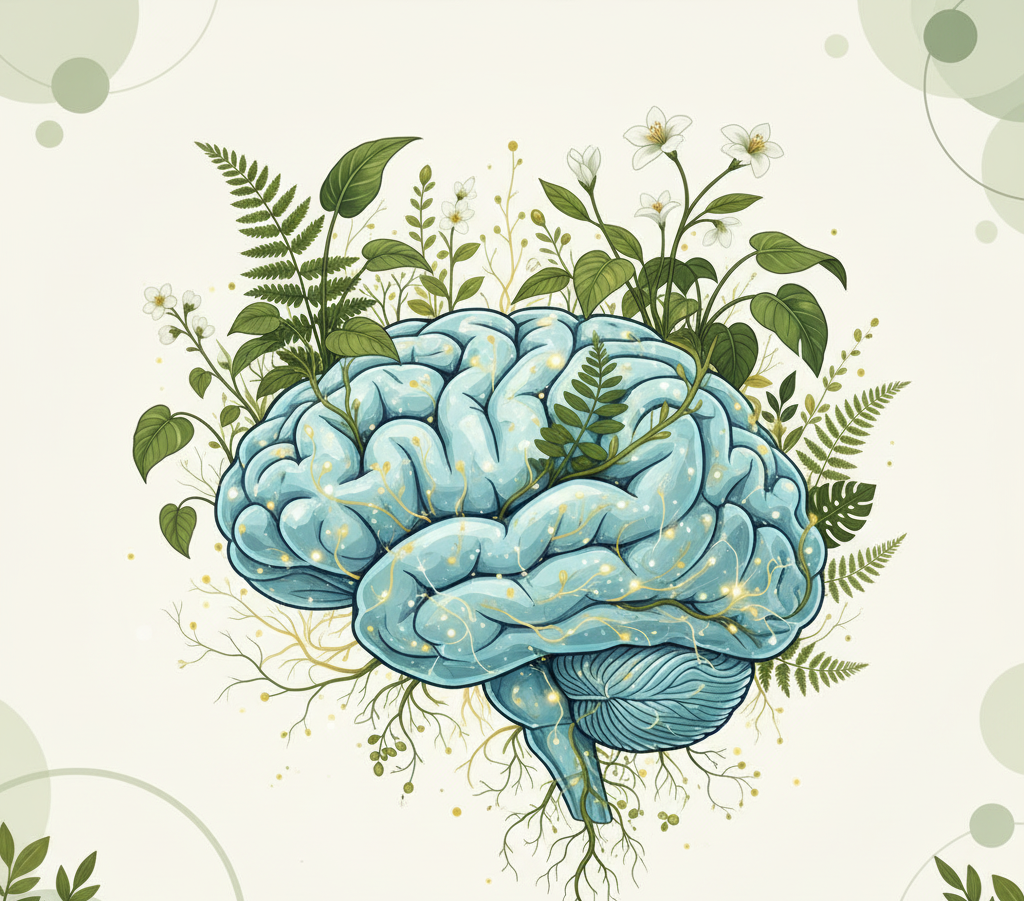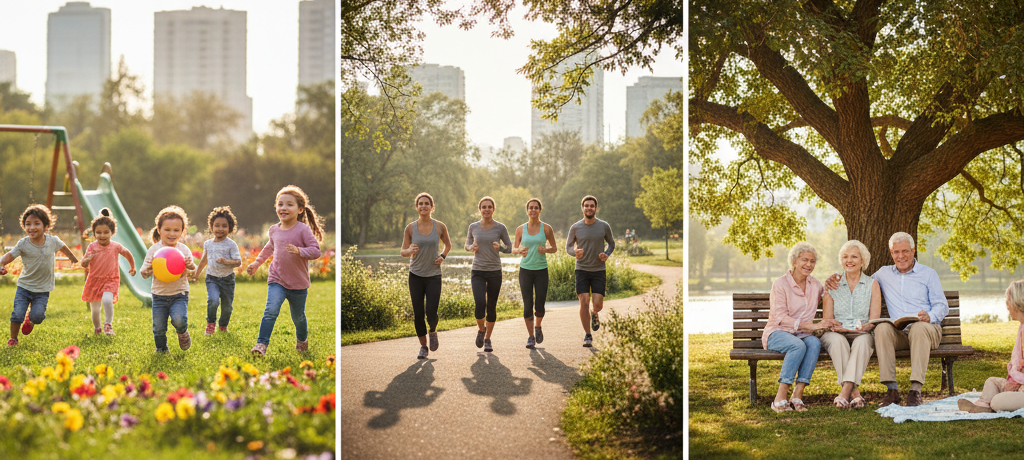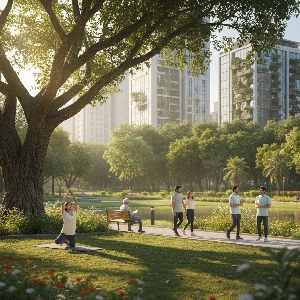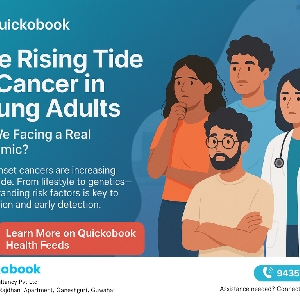Introduction
Imagine walking under trees, hearing birds sing, and feeling the calm of nature all around you. This isn’t just a peaceful moment — it’s a boost for your mental health. New studies have revealed that people who live near greener surroundings are less likely to require hospital treatment for mental illnesses. This link between nature and well-being highlights the deep mind-body connection we often overlook in modern urban life.
In India, where urbanization and stress are rising, the importance of green spaces cannot be overstated. Parks, gardens, trees, and even balcony plants can have measurable benefits for emotional stability, anxiety levels, and overall quality of life.
Understanding the Connection Between Nature and Mental Health
The human brain evolved in natural environments, not in concrete jungles. Exposure to greenery provides psychological relief, lowers cortisol (the stress hormone), and improves cognitive functioning. Research published in journals like The Lancet and Nature Mental Health shows that areas with higher levels of vegetation have lower rates of depression, anxiety, and schizophrenia-related hospital admissions.
People surrounded by nature often experience:
-
Better mood stability
-
Reduced symptoms of anxiety and depression
-
Lower stress and blood pressure
-
Improved focus and sleep
This phenomenon proves that environmental design plays a vital role in protecting and nurturing mental health at both individual and community levels.
How Green Environments Improve the Mind-Body Connection
The mind-body connection refers to how mental and physical health influence each other. Spending time in nature activates the parasympathetic nervous system, promoting relaxation and recovery. This leads to physical benefits such as lower heart rate, improved immune response, and better hormonal balance.
When the mind feels calmer, the body naturally follows suit. That’s why people who practice yoga, meditation, or even short outdoor walks often report improved energy levels and emotional balance.
In fact, urban residents who visit green spaces just once a week show significantly better psychological well-being than those who don’t.

Why Greenness Reduces Hospital Admissions for Mental Illness
Studies conducted across various countries have shown a clear pattern — communities with more green spaces report fewer hospital admissions for severe mental conditions like depression, bipolar disorder, and schizophrenia.
Possible reasons include:
-
Reduced social isolation: Parks and gardens encourage social interaction and community bonding.
-
Physical activity: Green spaces promote walking, jogging, and yoga — all known to boost serotonin levels.
-
Cleaner air: Trees filter pollutants, improving brain oxygenation and reducing fatigue.
-
Natural light exposure: Helps regulate sleep and mood through melatonin balance.
-
Stress recovery: Nature exposure lowers cortisol, protecting the brain from chronic stress damage.
In short, greener surroundings help create healthier minds and communities.
Simple Ways to Add Greenery to Your Life
You don’t need to move to a forest to enjoy the benefits of nature. Even small steps can make a big difference:
-
Grow indoor plants like money plant, aloe vera, or peace lily.
-
Spend 20 minutes outdoors daily, ideally near trees or gardens.
-
Add greenery to your workspace using small potted plants.
-
Take family walks in parks instead of malls on weekends.
-
Join community gardening groups to combine social and environmental wellness.
-
Encourage schools to develop green play areas for children.
Each small effort creates a ripple of well-being, benefiting both personal health and public health.

Mental Health Benefits of Greenness for Different Age Groups
-
Children: Better attention span and creativity; reduced ADHD symptoms.
-
Adults: Improved focus, mood, and productivity; lower burnout risk.
-
Seniors: Reduced loneliness, improved mobility, and lower dementia progression rates.
The presence of nature supports emotional resilience across all age groups, proving that mental wellness truly grows where greenery thrives.
Community Health and Environmental Policy
Urban planning that prioritizes parks, tree-lined streets, and rooftop gardens directly improves mental health outcomes. Cities like Pune, Bengaluru, and Chandigarh, known for their greener layouts, report higher life satisfaction compared to concrete-heavy metros.
Policymakers and health planners are now considering green infrastructure as a preventive tool against mental illness — not just an aesthetic choice.
The Role of Quickobook in Mental Health Awareness
At Quickobook, we believe in holistic healthcare. While greenery and lifestyle play major roles in maintaining mental balance, professional support is equally important. If you or someone you know feels persistently anxious, low, or stressed, you can book a mental health consultation online through Quickobook. Qualified psychiatrists, psychologists, and counsellors are available for both in-clinic and video consultations across India.
Mental health matters — and reaching out for help is a sign of strength.
50 FAQs: Mental Health, Nature, and Greenness
1. How does greenery improve mental health?
It reduces stress, promotes relaxation, and improves mood.
2. Can living near parks lower depression risk?
Yes, research shows people living near green areas have fewer depressive episodes.
3. What is the mind-body connection?
It’s how your thoughts, emotions, and physical health influence each other.
4. Can plants at home reduce stress?
Yes, indoor plants improve air quality and create calmness.
5. Does walking in nature help anxiety?
Absolutely, even 20 minutes in greenery can lower anxiety levels.
6. Are green cities healthier?
Yes, they report fewer hospital admissions for mental and respiratory illnesses.
7. Why does nature make people feel happier?
Exposure to sunlight and fresh air increases serotonin — the happiness hormone.
8. Can urban noise increase stress?
Yes, noise pollution contributes to anxiety and sleep issues.
9. What are some easy plants to grow indoors?
Aloe vera, peace lily, snake plant, and pothos are great options.
10. How does green exposure help children?
It improves focus, reduces ADHD symptoms, and supports emotional regulation.
11. Can greenery improve sleep quality?
Yes, natural settings reduce stress and help normalize sleep cycles.
12. How often should I spend time in nature?
At least 2 hours per week is beneficial for mental well-being.
13. What’s eco-therapy?
A therapeutic practice that uses nature-based activities to heal the mind.
14. Does gardening improve happiness?
Yes, it gives a sense of purpose and relaxation.
15. Can hospitals benefit from green surroundings?
Yes, patients recover faster and need fewer medications.
16. Is there proof that greenness reduces hospital admissions?
Yes, multiple global studies have confirmed this link.
17. Can exposure to greenery reduce suicide risk?
It may lower stress and loneliness, helping emotional balance.
18. Do urban parks reduce community stress?
Yes, they provide social space and reduce isolation.
19. Can spending time in nature lower blood pressure?
Yes, natural environments trigger relaxation responses.
20. Does sunlight affect mental health?
Yes, it helps regulate serotonin and vitamin D levels.
21. Can greenery help people with PTSD?
Yes, it supports mindfulness and emotional regulation.
22. Why is green color calming?
The brain associates green with safety and balance.
23. Can plants purify indoor air?
Yes, many plants absorb toxins and release oxygen.
24. Is living near trees good for the heart?
Yes, it reduces stress-related cardiovascular risks.
25. Can city planners improve mental health?
By adding more parks, trees, and natural light in urban spaces.
26. How can I make my workspace greener?
Add small potted plants or vertical gardens near your desk.
27. Are nature walks as effective as meditation?
They offer similar calming and restorative effects.
28. Can greenery prevent dementia?
It may slow cognitive decline in older adults.
29. Do green schools improve learning?
Yes, children in green environments perform better academically.
30. Can nature help in addiction recovery?
Yes, eco-therapy can support emotional healing and self-control.
31. How does green space help during stress?
It lowers cortisol and promotes serotonin release.
32. Can green roofs improve city health?
Yes, they reduce pollution and urban heat stress.
33. What’s the best time for outdoor walks?
Early morning or evening when pollution levels are lower.
34. Does looking at nature pictures help?
Even virtual nature scenes can relax the mind.
35. Can I combine yoga with nature therapy?
Yes, outdoor yoga enhances mental and physical balance.
36. How can greenery affect productivity?
Green views improve focus, creativity, and motivation.
37. Is gardening suitable for senior citizens?
Yes, it’s gentle exercise and emotionally rewarding.
38. Can green surroundings help students during exams?
Yes, they reduce anxiety and mental fatigue.
39. How can urban residents find greenery?
Visit parks, terrace gardens, or create indoor plant corners.
40. Can nature improve relationships?
Yes, shared outdoor activities enhance bonding and happiness.
41. Does greenery improve recovery from mental illness?
It complements therapy and medication by reducing stress.
42. Are rural people mentally healthier than city dwellers?
They generally have lower stress levels due to more natural exposure.
43. What are biophilic designs?
Architectural approaches that integrate nature into living spaces.
44. Can green spaces reduce healthcare costs?
Yes, by preventing illness and promoting faster recovery.
45. Does India have mental health-friendly green policies?
Several cities are now developing eco-parks and green belts for wellness.
46. What role does diet play along with nature exposure?
A nutritious diet enhances brain function and mood regulation.
47. Can nature walks replace therapy?
No, but they are a helpful addition to professional mental health care.
48. Is it safe to visit parks during high pollution days?
Avoid heavy smog days; choose cleaner mornings instead.
49. How can Quickobook help with mental health?
It connects you to psychiatrists, psychologists, and counsellors online or nearby.
50. What’s the key takeaway from green mental health studies?
More greenery means better emotional health and fewer hospital admissions.









Comments (0)
No comments yet. Be the first to share your thoughts!
Leave a Comment